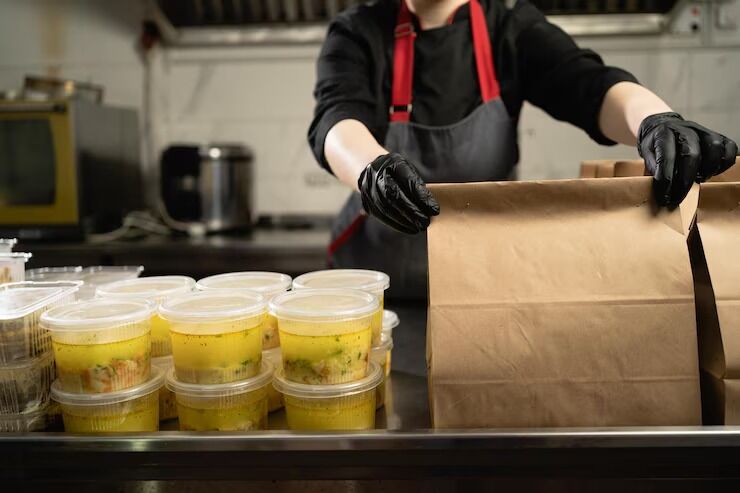What Every Restaurant Should Know About Hidden Risks in Take-Out Containers
Introduction: Why Restaurants Can’t Ignore Packaging Safety Anymore

In the foodservice industry, take-out packaging has quietly become a brand’s frontline ambassador. Every box, bowl, or cup that leaves your kitchen carries not only your food but also your reputation.
Recent consumer studies show how expectations have changed. According to McKinsey & Company (2025), U.S. consumers remain most concerned about food safety and shelf life—and least concerned about packaging appearance. Likewise, Market.us (2023) found that 75% of respondents rank hygiene and food safety as the foremost priority when judging food packaging.
These findings highlight a clear truth: customers are not simply buying a meal; they are trusting that your packaging will keep that meal clean, safe, and free from hidden toxins.
Yet, many restaurants still rely on low-cost, plastic-lined containers or unverified “food-grade” boxes. The problem? Food-grade does not always mean truly safe. As discussed in our article “Food Grade Packaging: Is It Truly Safe for Your Food?”, labels can be misleading if suppliers use uncertified coatings or recycled materials of unknown origin.
For restaurant operators, understanding these risks isn’t just about compliance — it’s about brand trust, customer loyalty, and long-term sustainability.
The Delivery Packaging Chain: From Kitchen to Customer
From the moment a dish leaves the pan to the moment a customer opens it at home, packaging goes through heat, humidity, vibration, and human handling. At each stage, safety can be compromised.
1. Kitchen & Packing Stage: Heat, Oil, and Steam Stress
Freshly cooked meals are often sealed immediately. Hot oil and steam can trigger chemical migration if the container’s inner layer contains plastics or PFAS-based coatings. When food is acidic, salty, or oily, the risk multiplies.
The same process that keeps your curry warm could also leach unwanted compounds into it.
2. Storage & Transportation: Pressure, Moisture, and Temperature Shifts
During storage and delivery, boxes are stacked, pressed, and exposed to fluctuating humidity. Temperature swings — from a hot kitchen to an air-conditioned vehicle, and back into the open air — cause expansion and contraction in layered materials.
If the packaging lacks proper structural strength or moisture resistance, seams can separate, leading to leaks or microbial growth on damp surfaces.
3. Customer Use: Heating, Reuse, and Disposal
The final stage is the least predictable. Many consumers reheat take-out meals directly in the same container, unaware that most plastics or PE-lined paper are not designed for microwave use. Others reuse “eco-looking” bowls multiple times, creating a hygiene hazard.
Additionally, recent research confirms that repetitive use of food packaging can significantly increase the migration of chemicals from the material into food, especially when exposed to heat and moisture (source: National Library of Medicine).
Key Safety Risks in Delivery Packaging Materials
1. Chemical Migration and Hidden Toxins
Migration happens when substances from the packaging move into the food — particularly under heat or contact with oil and acids.
Common culprits include:
- Plasticizers and monomers released from PP, PS, or PET plastics.
- PFAS coatings, used to make paper grease-resistant, but known as “forever chemicals.”
- Printing inks and adhesives that may contain heavy metals or volatile compounds.
These risks are discussed in detail in our post “What Is Truly Non-Toxic Dinnerware? A Safe & Sustainable Guide for Buyers.”
As that article explains, true non-toxic packaging avoids these additives altogether, ensuring compliance with international limits such as EU 2024/3190, which restricts bisphenols and other food-contact substances.
2. Moisture and Heat Resistance
Delivery containers must endure steam, condensation, and oil. Poorly engineered materials swell, wrinkle, or delaminate under moisture. Once structural integrity is lost, bacteria can enter through micro-gaps.
For example, a thin PE-lined paper box may look sturdy when dry but begin to soften within minutes after a hot, oily meal is sealed inside.
3. Structural Strength and Deformation
Stacked take-out boxes experience vertical pressure during transport. Lightweight plastic or thin-wall paper may warp, causing leaks or lid detachment.
The stronger the fiber structure — and the better the mold design — the safer the delivery.
4. Thermal Stability and Odor Barrier
High temperatures accelerate chemical reactions and odor migration. Plastic containers often absorb strong spices or release synthetic smells after heating.
Natural fiber packaging such as bagasse or bamboo, when properly pressed and tested, remains odor-neutral even under 100–120 °C conditions.
5. Environmental and Regulatory Compliance
Safety extends beyond chemistry. Regional regulations differ:
- EU 2024/3190 bans certain bisphenols in paper and board food-contact packaging.
- FDA 21 CFR governs additive migration limits for plastics.
- EN 13432 defines standards for compostable materials.
For restaurants operating across borders or on delivery platforms with sustainability targets, non-compliance could result in product bans or reputational risk.
Comparing Material Options: From Plastic to Pulp
| Material Type | Key Advantages | Limitations / Risks | Recommended Use |
|---|---|---|---|
| Plastic (PP, PET, PS) | Low cost, light weight, waterproof | May release additives under heat; poor biodegradability | Cold drinks or short-term cold storage |
| Coated Paper (PE or PFAS-lined) | Common for low-cost boxes | Plastic liner hinders composting; PFAS concerns | Dry foods only |
| PLA / CPLA Bioplastics | Plant-based and compostable | Softens above 60 °C; limited barrier strength | Salads, desserts |
| Aluminum Foil Containers | High heat tolerance, strong barrier | Not microwave-safe; high energy footprint | Oven-baked meals |
| Bagasse / Molded Pulp | 100 % renewable fiber, PFAS-free, heat-resistant, compostable | Not recommended for long-term storage of liquids | Hot, oily foods, full meals |
Non-Toxic Disposable Packaging Options
For operators aiming to combine safety, sustainability, and performance, the following materials stand out:
- Bagasse Tableware and Take-Out Boxes: Made from sugarcane fiber, offering heat and oil resistance up to 120 °C.
- Bamboo Fiber Bowls and Trays: Naturally antibacterial, strong, and compostable.
- Uncoated Paper Packaging: Suitable for dry snacks or bakery items.
These materials not only pass food-contact safety tests but also support eco-certifications and brand reputation.
Testing and Real-World Performance of Bagasse Packaging
At InNature Pack, our molded bagasse containers are engineered specifically for the food-delivery chain.
- Heat & Oil Resistance: Maintains shape up to 120 °C without warping or releasing odor.
- Leak-Proof Durability: Tested under 500 g of hot oil for 30 minutes — no seepage.
- Safety Compliance: Certified under EU 2024/3190, EN 13432, and FDA food-contact standards; completely PFAS- and BPA-free.
- Compostability: Fully decomposes in industrial composting within 60–90 days.
- Real-World Applications: Successfully adopted by cafés, catering services, and delivery chains that handle oily and high-temperature dishes.
For more detailed safety comparisons, see our case-based article “Are Sugarcane Plates Safe to Use for Food?”. It demonstrates how bagasse performs against traditional plastics in contact safety and temperature tests.
Take-Out Safety Checklist for Restaurants
| Check Point | What to Verify | Recommended Action |
|---|---|---|
| Material Transparency | Know the full composition, including coatings and inks | Request material declarations and migration reports |
| PFAS / BPA-Free Guarantee | Confirm absence of restricted chemicals | Ask for supplier certification |
| Heat Resistance | Can withstand 100–120 °C without softening | Conduct in-house oil and microwave tests |
| Oil & Water Resistance | Check for leaks or sogginess after 1–2 hours | Simulate delivery conditions |
| Stacking Strength | Boxes should resist deformation under load | Perform simple compression tests |
| Odor Control | No chemical or burnt smell after heating | Compare across materials |
| Regulatory Compliance | EN 13432 / EU 2024 / FDA approved | Keep documentation for audits |
| Customer Perception | Does packaging look clean, safe, and sustainable? | Use clear “PFAS-Free / Compostable” labels |
Implementing this checklist not only prevents complaints but also elevates your brand’s professionalism in an increasingly eco-aware market.
Conclusion: Safety, Sustainability, and Brand Trust Go Hand in Hand
Take-out packaging safety is no longer an optional feature — it’s a cornerstone of consumer trust.
The message from data and customer behavior is clear:
- Consumers care most about hygiene, food safety, and shelf life, not glossy logos.
- “Food-grade” claims without verified testing can expose brands to legal and reputational risk.
- Choosing non-toxic, PFAS-free, and compostable packaging demonstrates responsibility that customers can feel — literally — in their hands.
As restaurant competition intensifies, the smartest move is to adopt packaging that protects both people and the planet.
InNature Pack’s bagasse-based solutions offer exactly that: safe, durable, and biodegradable containers tested for real-world delivery conditions.
If your restaurant wants to switch to safer, non-toxic take-out containers or receive certified bagasse samples, contact InNature Pack for consultation. Together, we can make every delivery as safe as it is sustainable.
